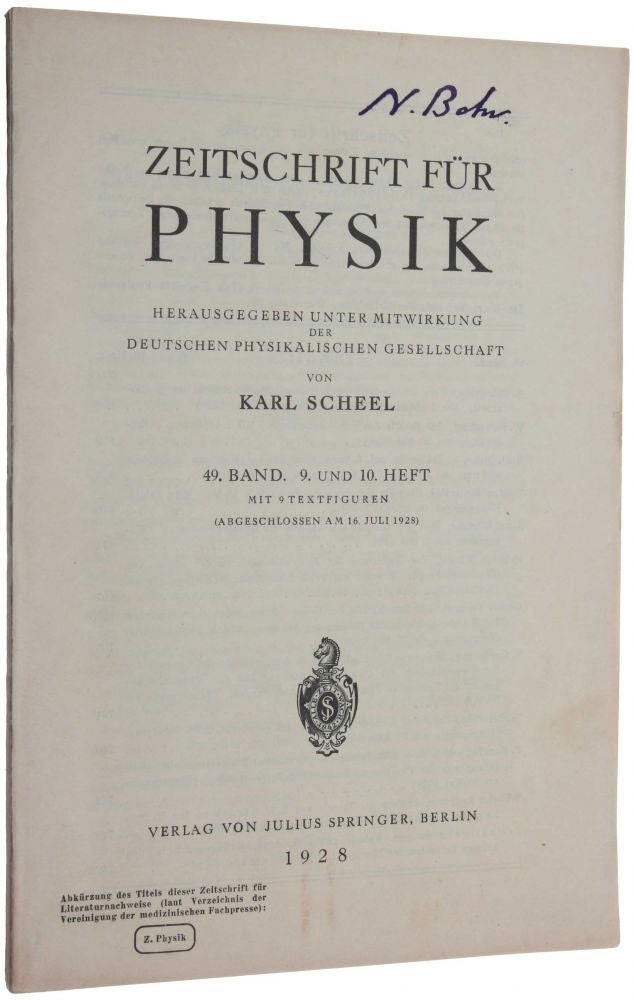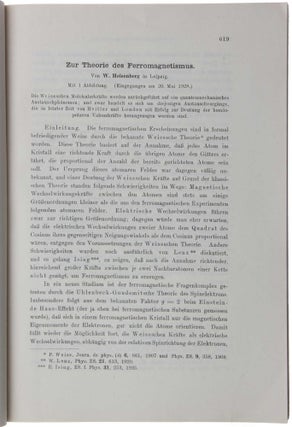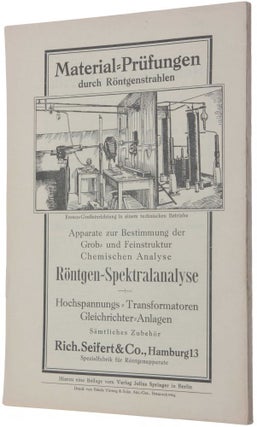‘Zur Theorie des Ferromagnetismus,’ pp. 619-636 in Zeitschrift für Physik, 49. Band, 9. & 10. Heft.
Berlin: Julius Springer, 1928. First edition, journal issue in original printed wrappers, of Heisenberg’s solution of the problem of ferromagnetism, and a remarkable association copy linking two of the greatest figures in twentieth-century physics. Bohr and Heisenberg are also linked by the subject matter of the present work. In his doctoral thesis Studier over Metallernes Elektrontheori (1911), Bohr proved what was later called the ‘Bohr-van Leeuwen theorem’, which shows that classical physics cannot account for magnetic phenomena. This probably provided at least part of the motivation for his subsequent work on quantum theory, of which Heisenberg gave the first mathematically consistent formulation in 1925. In this paper, Heisenberg applies his new quantum mechanics to finally explain one of the most puzzling magnetic phenomena, that of ferromagnetism. This is the ability of certain substances, such as iron, cobalt, nickel, etc., when cooled below a certain temperature (called the ‘critical temperature’), to develop a spontaneous magnetization, even in the absence of an external magnetic field. When a material is magnetized, the ‘magnetic moments’ or ‘spins’ of the individual atoms of the material are aligned (the atoms themselves are like tiny magnets and their north-south axes point in the same direction). The central idea of the Heisenberg model of ferromagnetism is that it is the quantum mechanical ‘exchange interaction’ between neighbouring atoms which is responsible for the tendency of these atoms to have their spins aligned rather than point in opposite directions. This exchange interaction has no classical analogue; it results from the ‘overlapping’ of the (orbital) quantum mechanical wave functions of two nearby atoms. Symmetry of the hybrid orbital is dictated by the nature of the spin alignment which obeys the Pauli exclusion principle. Thus there is an apparent spin-spin coupling due to orbital symmetry and this can, under certain circumstances, lead to a stable configuration in which the spins are aligned. Provenance: From the library of Niels Bohr with his name (‘N. Bohr’) stamped on upper cover. “Following a series of papers published in the years 1925 to 1927 — during which quantum mechanics was developed, interpreted and applied to atoms with more than one electron outside a closed shell — Werner Heisenberg solved the mystery of ferromagnetism using the concept of spin plus the exclusion principle formulated by Wolfgang Pauli, which states that two electrons with the same energy and momentum cannot occupy the same quantum state. In other words, two electrons with the same energy but different spins can lie in the same orbital. The facts that an electron has spin, as well as charge, and that two identical electrons must occupy different states, are the keys to the periodic table. “Until then, the force aligning the electron spins could not be explained in terms of known interactions, none of which was strong enough. In the words of Paul Dirac: “the solution of this difficulty [...] is provided by the exchange (austausch) interaction of the electrons, which arises owing to the electrons being indistinguishable one from another. Two electrons may change places without our knowing it, and the proper allowance for the possibility of quantum jumps of this nature, which can be made in a treatment of the problem by quantum mechanics, gives rise to the new kind of interaction. The energies involved, the so-called exchange energies, are quite large.” “By applying such an energy tax on indistinguishable particles, Heisenberg proposed a model that counted up all the spins and included the exchange interaction between nearest neighbours only; for example, in a linear chain of spins, only two neighbouring spins would count, in a square lattice, four. When these were summed, Heisenberg found a ground state (lowest-energy configuration) in which all the spins of the electrons lined up in parallel — that is, a ferromagnetic state without the need for any external magnetic field” (Nature Milestones: Spinhttp://www.nature.com/milestones/milespin/full/milespin05.html). From 1924 to 1927, Heisenberg (1901-1976) was a Privatdozent at Göttingen. In September 1924 Heisenberg went to work with Niels Bohr, director of the Institute of Theoretical Physics at the University of Copenhagen. In the following May, he returned to Göttingen and, with Max Born and Pascual Jordan, over a period of about six months, developed the matrix mechanics formulation of quantum mechanics. His seminal paper ‘Über quantentheoretische Umdeutung kinematischer und mechanischer Beziehungen’ was published in September 1925. On 1 May 1926, Heisenberg began his appointment as university lecturer and assistant to Bohr in Copenhagen. In the following year, Heisenberg was appointed ordentlicher Professor of theoretical physics and head of the department of physics at the University of Leipzig. “Heisenberg’s research in Leipzig concentrated upon applications and extensions of quantum mechanics. In 1928 he showed that a quantum-mechanical exchange integral that had played a crucial role in his earlier solution of the helium problem could account for the strong molecular magnetic field in the interior of ferromagnetic materials” (DSB).
8vo (229 x 155 mm), pp. 609-752. Original printed wrappers. A very fine copy.
Item #3526
Price: $2,850.00




